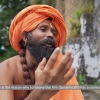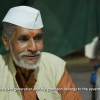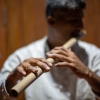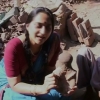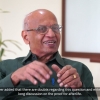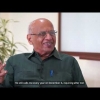Titas De Sarkar: Let us begin with the time when you were born, in 1933...
Soumendu Roy: 33' is my official date but I was born in 1932...
T.D.S: If you could kindly say where...
S.R: North Kolkata...
T.D.S: When was the first time you gained an interest in cinematography and how?
S.R: Even I don't know why or how it initially happened. In our times cinema was not really looked at with much respect. So it was a huge problem to be associated with films. I was raised in a joint family. There my own elder brother and cousin brothers had their cameras with which they took photographs. So I thought that if even I had a camera, I could click a few pictures. But who will give me a camera then. When I was in Class 8, a new boy came to our class. His name was Ashish Raha. We became friends. I came to know that his elder brother had a studio which had cameras of the latest model of that time. So I told Ashish if he could teach me photography since I had an interest in it but had no camera of my own. He readily agreed and I got my preliminary training from him. Afterwards, when I passed my matriculation examination, I was presented with a Kodak camera, which was my first personal camera. I took pictures with this as well as Ashish's camera. I processed these in their dark room, and like this the interest gradually grew. Then, his own relatives were into filmmaking and so I had a chance to watch the shooting of a couple of their films. From there we thought that if we too learn how to do photography, it would be quite interesting. But then Ashish went abroad and I continued with my studies in college. But I never had an inclination towards studies. I had a tremendous interest in getting into films, although then I had no means. But as I said, because I lived in a joint family, many people used to visit us. So on the occasion of my cousin sister's wedding, a man came to our house with his family. I heard that he was a filmmaker named Hiranmay Sen. I asked my mother if anything could work out. There was no reason to tell my brothers or my father about it. Initially she didn't agree to it but later on went ahead and talked to him. He said that I couldn't do anything, but if my cameraman Ramananda Sengupta agrees to it, something could be done. He kept his word and talked to Ramananda Sengupta and when Ramananda Sengupta came to know that I came from the family where he was acquainted with my cousin brother, he agreed at once and called me over. So that is how I met him and started to work in the Technician’s studio.
T.D.S: When did you first meet Satyajit Ray?
S.R: That was 1954 when the shooting of ‘Pather Panchali' resumed with the Government's aid. There I was hired as the caretaker of cameras. That was when I first met Satyajit Ray, Subrata Mitra and Banshi Chandragupta.
T.D.S: Pather Panchali, and then Aparajita and Apur Sansar were shot over a period of many years. So during that time, how were the conversations between you and Ray? On what did you talk about?
S.R: See, then I was an absolute novice. So there wasn't much of a conversation between us. It was only with Subrata Mitra or Banshi Chandragupta. I talked to them to learn. Because then we didn't have libraries or an opportunity to read books or watch films that would help me. So I worked and learned at the same time. When I became a bit old, I used to ask a few questions to Manik -da. In that way I was lucky enough to get three teachers - Satyajit Ray, Banshi Chandragupta and Subrata Mitra. I learnt by watching them and asking them questions.
T.D.S: Your first project with Ray as his cameraperson was in his documentary on Rabindranath Tagore (released in 1961). When did you first get to know that you'll be working with him directly?
S.R: In the year 1960 the Government approached him to make a documentary on Rabindranath Tagore on his birth centenary the next year, and Manik -da himself too decided to make turn three of Tagore's stories into films - Postmaster, Samapti and Manihara. He said to me that see I'm making two films, and you do the documentary.
T.D.S: So during the making of this documentary, or from the time when you were working with him since Pather Panchali, what did you think of his approach towards filmmaking? Did you find anything new in his perspective?
S.R: I was new back then, and didn't understand much. But from watching other films I felt that his films were very natural, normal - as was seen in Pather Panchali itself. In documentaries, it is a different kind of making - at Tagore's own house, with child Rabindranath and so on...
T.D.S: Speaking of Teen Kanya, with three short stories making a film being such a new concept in Bengal as well as India, what kind of thinking went into the making this?
S.R: Something like this was never tried before, as in one film with three different short stories. When Subrata babu couldn’t do this one due to several other commitments, Manik-da said you do this one as well, because I have to release it in 61’ itself. He said that these three stories have three different moods. I asked him to explain it further. He said, since Postmaster is the story of a sad little child, I'll shoot it in a cloudy atmosphere. It was really challenging to shoot in such conditions back then, the technology was not very advanced like today. On top of that it was my first feature. A nervousness and fear was working due to it. About Samapti he said that it is a romantic-comedy, so the shooting will also reflect that brightness. And Manihara was unnatural, so my approach to it will be likewise. The framing, lighting everything will be ‘unnatural’. So right from the beginning, I learnt a lot from these three films.
T.D.S: On the question of learning, did Ray ask you to watch certain kind of films or learn from any particular cinematographer?
S.R: Not really. Thing is, not many foreign films used to come here. He asked us to watch whatever came. But what he emphasised was to see the paintings and photography of the great masters. From there you can learn about light and set, composition and so on.
T.D.S: A few years later Ray made 'Dui' which was silent. In that respect were there any added responsibilities as a cameraperson, because it had no dialogues?
S.R: Not any such responsibilities were there on the camera. But the difference between the rich and the poor men had to be brought out through changes in locations and its framing.
T.D.S: You were also there with Ray when he made his first detective film -Chiriyakhana. This film had a huge cast and the set too was quite large as the film had several families to portray. For how long did you work on this set and what were the challenges shooting it?
S.R: Golap Colony had to be shot outdoors. I have forgotten the name of the place but it was a huge compound where it was shot. The scenes that had to be shot at night were demanding. There were no generators then, the voltage used to fluctuate, and I had to work with such lights back then which were nowhere near to what we have today. I faced these problems, but anyway, everything worked out just fine.
T.D.S: If you elaborate a bit about how you exactly shot the nighttime scenes, facing such challenges...
S.R: Because it was shot outdoors, it had its own difficulties like placing the lights. Because the intensity of the lights were not that great, it was a problem to take long-shots. I faced all these, but Manik -da helped me out. He used to listen to the problems and tried to shoot without compromising on the framing or even change it if required.
T.D.S: Do you remember instances of any such framing which was extremely challenging to shoot but later on went on to become quite popular?
S.R: That was in Goopy Gaine Bagha Baine. When Manik-da decided to shoot Goopy Gaine Bagha Baine, he said that in my story I have two kinds of Kings - a good one and a bad. So the set and lighting for them will be different. The set of the good king of Shundi will have the effect of black and white marbles while that of the Halla Raja's court will have geometrical patterns. At that time the colour white was used differently. I had to control the use of that colour there as well as how the shadows would configure in it.
T.D.S: While we are on the subject of black and white films, we already know the many challenges of shooting it. But what is the biggest advantage of shooting such a film which is not in colour?
S.R: This is a personal opinion, but I feel that shooting in black and white is more challenging than in colour. You can separate the many colours in the latter, whereas that separation black and white can only be done with the help of proper lighting.
T.D.S: If you talk about the all too talked about sequence in Goopy Gaine, that of the dance of the ghosts. How did you shoot it?
S.R: We divided the shot into four separate stages, using four different colour schemes. Then the four were merged using special effects.
T.D.S: We have seen many photographs where Satyajit Ray is himself handling the camera. So before taking a shot, did he guide you as to how it is going to be shot, or did you also have a free hand in that process?
S.R: He told us everything. He did the framing. He showed the movements, and how the light is going to come from the background.
T.D.S: So were there any instances in any film of Ray's when you thought that a shot could be taken a bit differently?
S.R: You know what happened before the shooting started for any film was that we used to do a lot of homework. We used to ask a lot of questions then. So a basic idea was already there even before the shooting began. Then if there were any last minute improvisations that were required, then as I said, Manik-da used to do that accordingly. For instance, there was a scene in Ghare Baire set in the drawing room of Nikhilesh. There were big mirrors in the right hand side there. It was a night time scene. There were light sources both above and below. I noticed that some of the lights were reflecting off the mirrors. I usually didn't tell anything to Manik-da if I wasn't wholly unable to pull it off. But he was there on the set and he understood that something was not right. So he called me and enquired whether all the lights were in place. I said that not everything is ready but he asked me to turn on whatever was put up and called Soumitra and Swatilekha. There were movements in that shot. He saw the problem, and made minor changes, which solved the problem. So I had this advantage.
T.D.S: You worked with him roughly from around 1955 to 1985 - from Pather Panchali to Ghare Baire. In this long period, what kind of changes did you see in Ray’s idea of cinematography?
S.R: In my own opinion, the core belief of Ray was to tell the story. So we shot any film according to its own requirements. Like Goopy Gaine Bagha Baine worked on metaphors. So the kinds of scenes you’ll get there is not the same as in Jana Aranya. And if you talk about colours, the one in Satranj Ki Khiladi won't be there in Ashani Sanket.
T.D.S: The city of Kolkata became one of the central themes in films like Pratidwandi, Seemabadhha or Jana Aranya - very different from Goopy Gaine or Teen Kanya. One of the allegations that was made against Ray before these films were made was that he wasn't addressing the contemporary issues. These three films came almost as a corrective for that. So while shooting these films, what aspects of the city did Ray ask you to capture?
S.R: See for all these films, although they were based in Kolkata, the way we showed the city in Pratidwandi was not how it was shown in Seemabadhha. Although the events of Seemabadhha happened in Kolkata, most of the scenes were inside an office and the drama unraveled there itself. And in Jana Aranya again, Kolkata was shown in different ways. The slum areas were shown here, which weren’t shown in Pratidwandi.
T.D.S: In Jana Aranya we had scenes from Maidan to the slum areas to that of Burrabazar...
S.R: Yes, Burrabazar where all kinds of transactions take place.
T.D.S: This automatically brings to mind the question of the crowd. Was it challenging to shoot in Calcutta?
S.R: Yes we faced problems shooting in Burrabazar. So in order to finish shooting in Burrabazar on time, we had to shoot it in documentary style. It was shot completely in a hand-held camera like in the documentaries.
T.D.S: Ray himself wrote about the crowd in his books while shooting for Joy Baba Felunath. How so many people used to congregate in the ghats. He talks about how people were deliberately misdirected about the venue of shooting to avoid the crowd. If you talk about such experiences.
S.R: What we faced in Joy Baba Felunath were narrow lanes. There was a night time scene in one such lane, where the actors were walking after having paan - the murder sequence. Manik-da had already checked out the locations. I too had an understanding about where to put the lights. I started my work from the afternoon itself. This was another long shot. But when we came back to shoot there was a huge crowd, spilling over. There were heads as far as you can see. If we tried to move these people, then we would never get our work done. Manik-da said that it is impossible to shoot like this, we’ll have to do it indoors and create a set for it. The elders of the neighborhood saw this and said that it would be really unfortunate if Satyajit Ray goes back without shooting there. We went back to our hotels and the senior members met us there and asked us to give them one day to sort things out. They kept their word and we shot there quite peacefully.
T.D.S: The other Feluda movie - Sonar Kella - was shot in Rajasthan, where we have some memorable scenes like that with the train chase. How did you shoot the sequence with the camels chasing the train in the desert?
S.R: We didn't have cranes then. So we placed the camera on a truck and pushed it and the trolley went with it.
T.D.S: How long did it take to shoot the entire sequence?
S.R: It took an entire day but we avoided shooting in the evening. But we took another day to shoot with the train.
T.D.S: Ray's films are also known for its child actors. Did you have to have a different sort of understanding with these children, while shooting them - from Sonar Kella to Joy Baba Felunath?
S.R: Thing is, Manik-da could do away with their sense of fear. He dealt with them as adults and not as if they were children. He used to play games with them before the shooting. This friendliness helped with the coming over of their nervousness. The same thing happened with Mukul in Sonar Kella or Jeet in Joy Baba Felunath. He used to buy various kinds of games and play with them. They thought him to be one of their friends. He was very successful in this regard.
T.D.S: Another film deserves mentioning - Satranj Ki Khiladi. Usually Ray made his films on a low budget. This on the other hand, had a sizeable budget. Did this have any positive impact on the kind of cameras or other instruments that you used?
S.R: Yes to a certain extent. Because of the budget I could import a few lights. Bulbs, to be specific. Otherwise the shooting was pretty normal, what usually happened.
T.D.S: Because it was quite large in scope - both conceptually and visually - did Ray give you any specific advice regarding ways to shoot it?
S.R: Unlike in Ashani Sanket where he asked us to keep the palette subdued, here the colours were very vibrant. "The colours should come out well". The Nawabi culture had to be reflected in the costumes. This is more or less what he said.
T.D.S: Did you later on feel that it would have been better if such colours could also be used to show the royal courts in Goopy Gaine Bagha Baine? Instead of those films being in black and white.
S.R: It is hard to say whether it would have been good or bad, but the surprise that Ray gave by making the last scene in colour would have been lost if the entire film was in colour.
T.D.S: Shooting Aranyer Dinratri must have been another different experience. Not only was it set in the forests, it had a few nighttime scenes as well and of course many outdoor shots. How did Ray's approach shift while shooting indoor and outdoor sequences? Light must have been one crucial element that had to be taken into consideration.
S.R: Yes, as I said, we didn't have such lights back then as we have today. We had to manage with reflectors. If we were shooting indoors, we used to overexpose the outside spaces and give importance on the action inside the room.
T.D.S: Moving on to the documentaries, one got to see Sikkim a few years back. If you could talk about how the shooting took place, when you went there and how you captured it...
S.R: Sikkim at that time was not under the Government of India. It was a different entity. They told us beforehand not to bring any heavy equipment. It was advised to carry light instruments due to the condition of the roads. So we didn't take any reflector with us. What I had were two batteries apart from the cameras. Manik-da also didn't take any huge equipment, he had an open machine. We worked with those things.
T.D.S: While shooting the festival, what kind of response did you get from the local people?
S.R: Very good. The film was being made under the orders of the King and Queen. They didn't know then that Sikkim would come under the Indian Government. Since the Queen was American herself, this film was made to attract the American tourists. So we didn't have any problem while shooting.
T.D.S: Inner Eye - a documentary on an individual - was shot few years after Ray shot 'Rabindranath Tagore'. So was his approach any different now than it was a decade back?
S.R: Thing is, we never got to shoot Tagore in person, and his documentary was on someone who had already passed away. This was different in Inner Eye. On Benode da, the idea was to capture him as we have seen him. Not too much light was used if it was not necessary. Even if that meant shooting in the darkness. It is with this approach that I did Inner Eye.
T.D.S: Did you get to know why Ray chose to do a documentary specifically on Benode Behari Mukherjee?
S.R: He was approached by the Government of India film division as Manik-da was a student of Benode Behari. It was from this interest that Manik-da did this documentary.
T.D.S: Just after a few years, Ray did a documentary on Balasaraswati, titled 'Bala', which is now available in full on YouTube. It is on a dancer, where movement has a very important role to play. So how did you try to capture it?
S.R: Manik-da told me not to indulge in any fancy things and take a simple approach to it. Her dance was the main thing, her mudras. So I had to capture those mudras very clearly. So I didn't try anything extra while shooting Balasaraswati.
T.D.S: Ray had worked with several actors, Soumitra Chatterjee obviously being one of them. You have worked with Chatterjee right from Abhijan to other later films. Did Ray have any particular instruction for shooting him or any other actors? For instance we know of Suchitra Sen who wanted to be shot only from certain angles.
S.R: No, not really. What Manik-da really emphasised on was the dialogue and how the new artistes were saying it. He used to write it keeping in mind the actors and how it’ll help them perform it. He didn’t mention any specific angle for anybody, we shot it how we usually see them.
T.D.S: This is more out of curiosity than anything else - today we have the opportunity to use a wide range of cameras. If Ray shot a film today, what do you think he could have further incorporated due to this advantage, which wasn't available in his time?
S.R: It is true that technology has improved and is being used differently, but I feel that today the instruments are taking a precedence, even where it is not necessary. But people are indulging themselves all the same.
T.D.S: Another crucial aspect of filmmaking is that a large part of whatever is shot is edited out. Do you have regrets in this regard about such shots which came out well, but could not be kept in the film?
S.R: Ashani Sanket.
T.D.S: Okay.
S.R: I went during the editing and saw what was going on. Manik-da saw me then and said that I know you feel bad about many nice shots being edited out, but a director have to be ruthless for the sake of his films. Because of the tempo, of the mood.
T.D.S: You worked for such a long time with Ray. From the point of view of the craft, what do you think you have learnt the most from him, which even helped you while working with other filmmakers? What would be that one lesson?
S.R: Language. The language of cinema.
T.D.S: How was this similar or different from Ray’s contemporaries?
S.R: See, everyone has a different approach. Like, Tapan Sinha's approach was sort of similar to that of Manik-da. But Tarun Majumdar's approach was different.
T.D.S: How were they different exactly?
S.R: Tapan-da's shot taking was pretty simple which was slightly different in the case of Manik-da. Tarun-da’s films had a commercial angle to it. I had to do the lighting according to the required mood, which I had to change in Tapan-da or Manik-da's case as they wanted to keep things normal. But for others, I had to make it a bit ‘un-natural'.
T.D.S: Do you regret not being part of any of Ray's films where you were not the cinematographer?
S.R: I cannot possibly answer this question because a different cameraman had a different approach. He worked according to his own ideas.
T.D.S: If one talks about any film in general, leaving out who did the camerawork...
S.R: Well no. One always wishes that he could work in all of Ray's films. But it didn't happen because of various reasons.
T.D.S: If you could talk about any incident outside of the shooting, when the filming wasn't taking place. Any such story which happened behind the camera, and we don't know about.
S.R: Many things used to happen outdoors. There was a scene in Joy Baba Felunath where Feluda and Topshe are going to Maganlal Meghraj's house. Since oxes are very famous in Benaras, Manik-da said that if he could show one, then another aspect of Benaras could be captured. But you can't get an ox just like that, you can't bring it by force. But Satyajit Ray has said it - so our own people as well as the locals tried to help us out. And the lanes of Benaras are very narrow and dark. I was fearing that if we don't get an ox, probably we wouldn't be able to shoot for the day. I told Manik -da that the light is slowly fading. He kept on saying let's see what happens. Suddenly we heard a shouting "it is coming! It is coming!” That the ox was coming. Who is bringing it? We had an actor named Kamu Mukherjee. What he did was he held a radish in front of an ox. He used it as a bait and was bringing the ox to our direction. He was coming from a long distance, from about a ten to fifteen minutes afar. He came and asked Manik -da, where do I bring him? Manik-da said, keep him here. He kept the radish there, and as the ox went ahead, our shot was done!
T.D.S: When was the last time you spoke to Satyajit Ray?
S.R: It was during Ghare Baire. On the last day of the shooting. After that I didn't do any film with him. I met him but he was pretty ill. For Ghare Baire he said that he wanted a certain kind of tone in it. A periodic tone. We had to create that tone. I created a warm tone throughout the film.
T.D.S: We'll end today's interview on a slightly different note - Standing today, with all the films that are being made around us, if Ray was still alive, what would be that one thing that you would ask him?
S.R: I would have said, Manik-da, don’t make films anymore.
T.D.S: Thank you.


